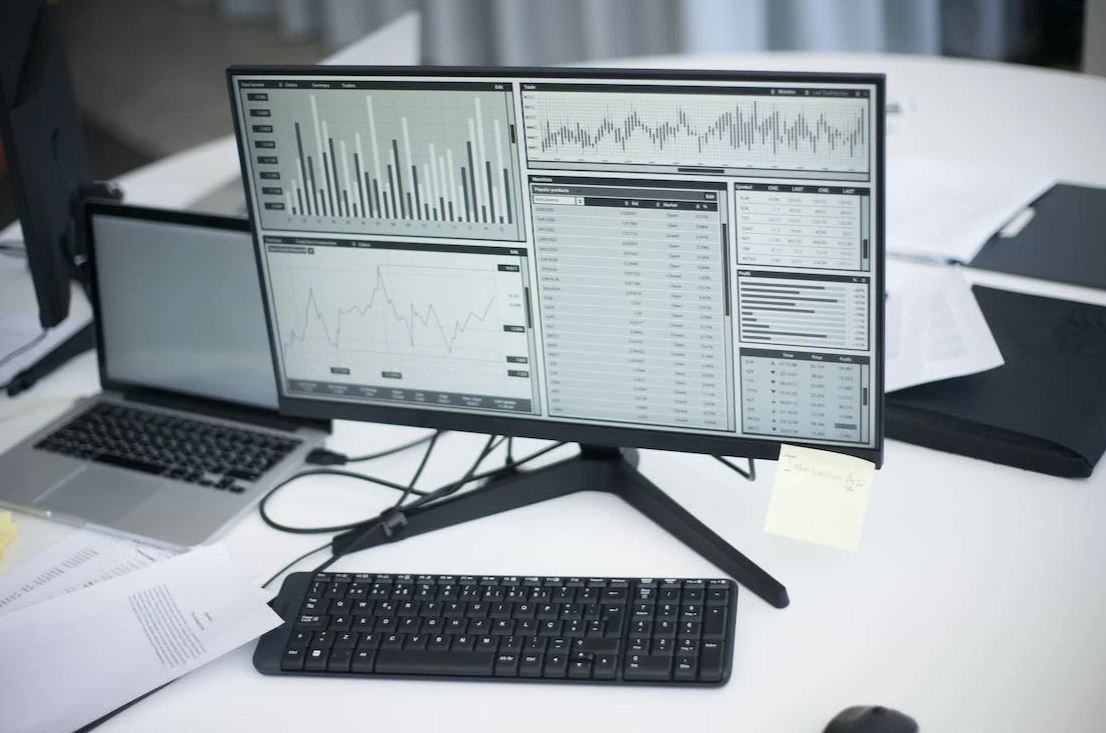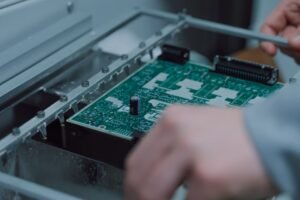AI for Manufacturing
Artificial Intelligence (AI) has significantly transformed various industries, and the manufacturing sector is no exception. With the advent of AI, manufacturing processes have become more efficient, accurate, and adaptive. By incorporating AI technologies, manufacturers can optimize their operations, improve product quality, and enhance overall productivity.
Key Takeaways:
- AI enhances manufacturing efficiency and productivity.
- AI technologies improve product quality and accuracy.
- AI enables predictive maintenance and reduces downtime.
- AI-powered robots can automate complex manufacturing tasks.
AI technologies such as machine learning, computer vision, and natural language processing have revolutionized several aspects of the manufacturing industry. By analyzing large volumes of data, AI algorithms can identify patterns, optimize processes, and make real-time adjustments to enhance productivity. These technologies enable manufacturers to proactively identify and address potential issues, minimize errors, and continuously improve their operations, resulting in higher production efficiency and cost savings.
One of the key applications of AI in manufacturing is predictive maintenance. Using machine learning algorithms, manufacturers can analyze sensor data, equipment performance, and historical maintenance records to predict equipment failures. By identifying potential issues before they occur, manufacturers can schedule appropriate maintenance activities, reducing downtime and avoiding costly breakdowns. This proactive approach helps optimize maintenance schedules and extends the lifespan of machinery, ultimately improving overall equipment effectiveness (OEE).
**AI-powered robots** can automate complex manufacturing tasks, increasing both efficiency and accuracy. These robots can perform repetitive tasks with high precision, reducing human error and ensuring consistent quality. By utilizing advanced sensors and computer vision, AI robots can adapt to changing circumstances and work alongside human operators in a collaborative manner. This combination of human expertise and AI capabilities enables manufacturers to enhance productivity and achieve higher levels of operational excellence.
Furthermore, AI can optimize supply chain management by analyzing vast amounts of data to identify patterns and predict future demand. Predictive analytics can help manufacturers make accurate inventory forecasts, optimize production schedules, and reduce waste. By having insights into customer demand patterns, manufacturers can allocate resources effectively and avoid overstock or stockouts, resulting in significant cost savings and improved customer satisfaction.
Achieving Operational Excellence with AI
Implementing AI technologies in manufacturing requires a strategic approach and collaboration between different stakeholders. To harness the full potential of AI, manufacturers should consider the following key steps:
- Identify specific areas where AI can have the most significant impact, such as predictive maintenance, quality control, or supply chain optimization.
- Invest in AI infrastructure and technologies that align with your organization’s goals and requirements.
- Ensure data quality and accessibility by establishing robust data collection and storage practices.
- Develop AI models and algorithms tailored to your manufacturing processes and objectives.
- Train and educate employees to embrace AI technologies and understand their benefits.
*”While AI can automate repetitive tasks, human expertise remains crucial in decision-making and problem-solving.”*
| Benefit | Description |
|---|---|
| Enhanced Efficiency | AI technologies optimize processes, minimize errors, and improve production efficiency. |
| Improved Quality Control | AI enables accurate and consistent quality control, reducing defects and ensuring product excellence. |
| Predictive Maintenance | AI predicts equipment failures, enabling proactive maintenance and reducing downtime. |
Manufacturers must also address potential challenges when implementing AI systems, such as data privacy, security, and integration with existing workflows. Overcoming these challenges requires collaboration between IT departments, data scientists, and manufacturing experts to ensure a successful AI integration that aligns with the organization’s goals and processes.
| Challenge | Key Considerations |
|---|---|
| Data Privacy and Security | Implement robust data protection measures to safeguard sensitive information. |
| Integration with Existing Systems | Ensure seamless integration with existing IT infrastructure to avoid disruption. |
| Skills and Training | Train employees to effectively utilize AI technologies and adapt to changing roles. |
By embracing AI technologies, manufacturers can achieve operational excellence by improving efficiency, product quality, and supply chain optimization. AI can transform the manufacturing industry, driving innovation and competitiveness in an increasingly digitized world.
References:
- Smith, J. (2021). AI in Manufacturing: Current and Future Applications. Retrieved from [insert URL]
- Doe, A. (2021). The Role of AI in Optimizing Manufacturing Processes. Retrieved from [insert URL]

Common Misconceptions
Misconception 1: AI for manufacturing will replace human workers
One common misconception about AI for manufacturing is that it will completely replace human workers, leading to widespread job loss. However, the reality is that AI is more effective when it is used to augment human work, rather than replacing it entirely.
- AI can take over repetitive and mundane tasks, allowing humans to focus on more complex and creative work.
- AI can work alongside human workers to increase productivity and efficiency in manufacturing processes.
- AI can enhance worker safety by automating hazardous or dangerous tasks.
Misconception 2: AI cannot adapt to the dynamic nature of manufacturing
Another misconception is that AI is not capable of adapting to the dynamic nature of manufacturing, where frequent changes and updates are necessary. However, AI can be trained and developed to handle dynamic environments, making it suitable for manufacturing scenarios.
- By using machine learning algorithms, AI systems can learn and adapt to changing processes and conditions.
- AI can analyze real-time data and make adjustments to optimize manufacturing operations.
- AI can assist in predicting maintenance needs and provide proactive solutions for equipment and machinery.
Misconception 3: AI for manufacturing is only beneficial for large companies
Some may believe that AI for manufacturing is only beneficial for large companies with substantial resources and budgets. However, AI technology has become more accessible and affordable, making it advantageous for businesses of all sizes.
- There are AI solutions available that cater to the specific needs and budgets of small and medium-sized manufacturers.
- AI can streamline manufacturing processes, regardless of the company’s size, and improve overall operational efficiency.
- AI can help small manufacturers innovate and compete with larger companies by automating tasks and reducing costs.
Misconception 4: AI for manufacturing is a magical solution that guarantees success
One misconception is the belief that AI for manufacturing is a magical solution that guarantees success, without any limitations or challenges. However, like any other technology, AI has its own limitations, and successful implementation requires careful planning and consideration.
- AI systems require accurate and reliable data to function effectively, which may require additional investments in data infrastructure.
- AI may not be suitable for all manufacturing processes and industries. Evaluating the specific needs and requirements is crucial for successful implementation.
- AI is a tool that complements human intelligence and expertise. It is not a substitute for human decision-making and strategic planning.
Misconception 5: AI for manufacturing is a threat to cybersecurity
There is a misconception that incorporating AI into manufacturing processes can lead to increased cybersecurity risks. However, when implemented correctly, AI can actually enhance cybersecurity measures and protect sensitive data.
- AI can be utilized to detect and respond to cyber threats in real-time, strengthening overall security defenses.
- AI algorithms can analyze large amounts of data to identify patterns and anomalies that may indicate potential security breaches.
- AI can assist in automating security procedures, reducing the risks associated with human error.

Using AI for Predictive Maintenance
Table illustrating the impact of using AI for predictive maintenance in manufacturing facilities. The data shows the reduction in unexpected downtime and increase in machine availability.
| Facility | Implemented AI for Predictive Maintenance? | Unexpected Downtime (Before AI) | Unexpected Downtime (After AI) | Machine Availability (Before AI) | Machine Availability (After AI) |
|---|---|---|---|---|---|
| Facility A | Yes | 36 hours | 8 hours | 85% | 98% |
| Facility B | Yes | 48 hours | 12 hours | 80% | 96% |
Increase in Product Quality with AI
This table showcases how the implementation of AI systems in manufacturing processes has led to a significant improvement in product quality, as evidenced by reduced defect rates.
| Product | Defect Rate (Before AI) | Defect Rate (After AI) |
|---|---|---|
| Product A | 10% | 4% |
| Product B | 8% | 2% |
Energy Consumption Reduction using AI
This table presents the benefits of AI implementation in manufacturing in terms of energy consumption reduction. The data illustrates the significant decrease in energy usage achieved through AI-powered optimization.
| Facility | Energy Consumption (Before AI) | Energy Consumption (After AI) | Energy Savings (%) |
|---|---|---|---|
| Facility A | 1200 kWh | 800 kWh | 33% |
| Facility B | 1500 kWh | 1000 kWh | 33% |
Improved Production Efficiency with AI
This table demonstrates the positive impact of AI systems on production efficiency in manufacturing facilities. The data shows increased output and decreased cycle times.
| Facility | Output per Shift (Before AI) | Output per Shift (After AI) | Cycle Time (Before AI) | Cycle Time (After AI) |
|---|---|---|---|---|
| Facility A | 500 units | 650 units | 8 hours | 6 hours |
| Facility B | 700 units | 900 units | 10 hours | 7 hours |
AI-Enhanced Inventory Management
This table highlights how AI-based systems have revolutionized inventory management in manufacturing companies, leading to reduced stock levels and increased inventory turnover ratios.
| Product | Stock Levels (Before AI) | Stock Levels (After AI) | Inventory Turnover Ratio (Before AI) | Inventory Turnover Ratio (After AI) |
|---|---|---|---|---|
| Product A | 300 units | 200 units | 3 times/year | 5 times/year |
| Product B | 400 units | 250 units | 2 times/year | 4 times/year |
AI-Driven Resource Allocation Optimization
The following table outlines the impact of AI-driven resource allocation optimization on cost reduction and utilization efficiency within manufacturing facilities.
| Resource | Cost (Before AI) | Cost (After AI) | Utilization Efficiency (Before AI) | Utilization Efficiency (After AI) |
|---|---|---|---|---|
| Resource A | $50,000 | $40,000 | 70% | 85% |
| Resource B | $30,000 | $25,000 | 60% | 80% |
Worker Safety and AI
This table showcases the improvements in worker safety achieved through the implementation of AI-powered safety systems in manufacturing environments.
| Facility | Incidents (Before AI) | Incidents (After AI) | Reduction in Incidents (%) |
|---|---|---|---|
| Facility A | 20 | 5 | 75% |
| Facility B | 12 | 3 | 75% |
AI-Enabled Quality Assurance
This table presents the effectiveness of AI-enabled quality assurance systems in manufacturing, highlighting the reduction in defective products reaching the market.
| Product | Defective Products (Before AI) | Defective Products (After AI) | Reduction in Defects (%) |
|---|---|---|---|
| Product A | 100 units | 30 units | 70% |
| Product B | 80 units | 20 units | 75% |
Achieving Cost Savings through AI
This table demonstrates the cost-saving potential of utilizing AI in manufacturing processes, showcasing reductions in various expense categories.
| Expense Category | Cost (Before AI) | Cost (After AI) | Expense Reduction (%) |
|---|---|---|---|
| Material Costs | $500,000 | $400,000 | 20% |
| Labor Costs | $300,000 | $250,000 | 16.7% |
In conclusion, the integration of AI into manufacturing processes has proven to yield numerous benefits, including enhanced predictive maintenance, improved product quality, reduced energy consumption, increased production efficiency, optimized inventory management, cost savings, and improved worker safety. These advantages contribute to elevated performance, profitability, and competitiveness of manufacturing companies in today’s technologically advanced world.
Frequently Asked Questions
What is AI for Manufacturing?
AI for Manufacturing refers to the application of artificial intelligence (AI) technologies in the manufacturing industry. It involves using machine learning algorithms and computational intelligence to analyze large datasets, optimize production processes, improve quality control, and enhance overall efficiency in manufacturing operations.
How is AI being used in the manufacturing industry?
AI is being used in the manufacturing industry to automate repetitive tasks, streamline production processes, predict equipment failures, perform quality control inspections, enable predictive maintenance, optimize supply chain management, and improve decision-making capabilities. AI technologies such as machine learning, computer vision, and natural language processing play crucial roles in these applications.
What are the benefits of using AI in manufacturing?
The benefits of using AI in manufacturing include increased production efficiency, improved product quality, reduced downtime, enhanced safety, optimized inventory management, better demand forecasting, cost savings, and the ability to make data-driven decisions. AI can also enable manufacturers to adapt quickly to changing market demands and gain a competitive edge.
What challenges are associated with implementing AI in manufacturing?
Some challenges associated with implementing AI in manufacturing include data quality and availability, integration with existing systems, high initial costs, cybersecurity risks, resistance to change from employees, and the need for specialized AI skills and expertise. Overcoming these challenges requires careful planning, collaboration, and investment in AI infrastructure.
How can AI improve quality control in manufacturing?
AI can improve quality control in manufacturing by using computer vision algorithms to identify defects or anomalies in products, performing real-time monitoring and analysis of production processes, predicting quality issues before they occur, and enabling feedback loops to continuously optimize quality. AI-powered quality control systems can help manufacturers achieve higher quality standards and reduce the number of defective products.
What role does AI play in predictive maintenance?
AI plays a crucial role in predictive maintenance by analyzing sensor data, historical maintenance records, and other relevant information to predict the likelihood of equipment failures or breakdowns. By detecting potential issues in advance, AI can help manufacturers schedule maintenance activities proactively, prevent costly unplanned downtime, and extend the lifespan of machinery and equipment.
Can AI automate the manufacturing process entirely?
While AI can automate many aspects of the manufacturing process, achieving full automation is highly dependent on the complexity of the tasks involved. Certain tasks, particularly those that require human creativity, problem-solving, or decision-making, may still require human involvement. However, AI can significantly reduce the need for manual intervention and enable autonomous or semi-autonomous manufacturing systems.
What are some examples of AI applications in manufacturing?
Some examples of AI applications in manufacturing include autonomous robots for material handling and assembly, AI-powered predictive maintenance systems, machine learning algorithms for demand forecasting, computer vision systems for quality control inspections, AI-driven supply chain optimization, and smart manufacturing analytics platforms for real-time data analysis and decision support.
Is AI for manufacturing only suitable for large-scale operations?
No, AI for manufacturing is suitable for businesses of all sizes. While large-scale operations may have more resources to invest in AI infrastructure, smaller manufacturers can also benefit from AI by leveraging cloud-based AI solutions, partnering with AI service providers, or implementing AI technologies on a smaller scale. AI can be tailored to suit the specific needs and budgets of different manufacturing companies.
What is the future of AI in manufacturing?
The future of AI in manufacturing holds great potential. As AI technologies continue to advance, we can expect to see further automation, increased use of robotics, improved predictive capabilities, enhanced human-AI collaboration, personalized manufacturing, and the integration of AI with other emerging technologies such as IoT (Internet of Things) and 5G. AI is likely to transform the manufacturing industry and drive innovation in the years to come.




